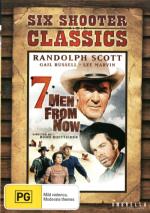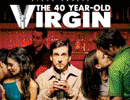7 Men from Now (Seven Men from Now) (Umbrella) (1956) |
|
7 Men from Now (Seven Men from Now) (Umbrella) (1956) |
|


|
| BUY IT |
| General | Extras | ||
| Category | Western |
Audio Commentary-author Jim Kitses Featurette-Budd Boetticher – An American Original (50:38) Featurette-The John Wayne Stock Company: Gail Russell (13:17) Featurette-Lone Pine (6:25) Theatrical Trailer Trailer-Batjac Trailers (6:00) Gallery-Photo More…-Credits (1:02) |
|
| Rating |

|
||
| Year Of Production | 1956 | ||
| Running Time | 74:51 (Case: 78) | ||
| RSDL / Flipper | Dual Layered | Cast & Crew | |
| Start Up | Menu | ||
| Region Coding | 2,4 | Directed By | Budd Boetticher |
|
Studio
Distributor |
 Umbrella Entertainment |
Starring |
Randolph Scott Gail Russell Lee Marvin Walter Reed John Larch Don 'Red' Barry Fred Graham John Beradino John Phillips Chuck Roberson Stuart Whitman Pamela Duncan Steve Mitchell |
| Case | Amaray-Opaque | ||
| RPI | ? | Music | Henry Vars |
| Video | Audio | ||
| Pan & Scan/Full Frame | None |
English Dolby Digital 2.0 (192Kb/s) German Dolby Digital 2.0 (192Kb/s) English Audio Commentary Dolby Digital 2.0 (192Kb/s) |
|
| Widescreen Aspect Ratio | 1.78:1 | ||
| 16x9 Enhancement |
 |
||
| Video Format | 576i (PAL) | ||
| Original Aspect Ratio | 1.85:1 | Miscellaneous | |
| Jacket Pictures | No | ||
| Subtitles |
English English for the Hearing Impaired Danish Dutch French German Italian Finnish Norwegian Swedish English Audio Commentary German Audio Commentary Spanish French Audio Commentary Italian Audio Commentary |
Smoking | Yes |
| Annoying Product Placement | No | ||
| Action In or After Credits | No | ||
Seven men rob the Wells Fargo office in Silver Springs, killing the female employee before escaping with $20,000. The female employee was the wife of ex-Sheriff Ben Stride (Randolph Scott) who goes after the men seeking revenge. Along the way Stride helps a couple from the East, John and Annie Greer (Walter Reed / Gail Russell), who are travelling by wagon to California and meets up with gunman Bill Masters (Lee Marvin), whom Stride had gaoled in the past in Silver Springs, and Clete (Donald Barry); Masters knows who committed the robbery but he is in no hurry to tell Stride for he is intent on getting the $20,000 for himself. As the group travel through hostile Indian territory towards the town of Flora Vista, where it seems the robbers are waiting, tensions arise especially when Annie and Stride become attracted to each other. Death in the desert seems inevitable.
Seven Men from Now was produced by John Wayne’s Batjac company and originally Wayne was to star in the picture but passed when he went to make The Searchers with John Ford. Instead, and after other actors were sounded out and passed, the lead went to Randolph Scott and Seven Men from Now became the first of the seven classic westerns, mostly written by Burt Kennedy, that Scott made with director Bud Boetticher between 1956 and 1960.
Seven Men from Now is important for a number of reasons. Randolph Scott had been acting in films since 1928 and had continued to work regularly in a number of genres including westerns. Now in his late 50’s Scott’s star may not have been completely on the wane but it was not vibrant either and Seven Men from Now regenerated his career; the Boetticher / Scott / Kennedy partnership in the late 1950s produced some of the best western B pictures every put on screen. Indeed, the last couple of films, Ride Lonesome (1959) and Comanche Station (1960), are right up there with the best of classic westerns.
In Seven Men from Now we meet the classic Scott character; a taciturn man seeking revenge for a tragedy in his past. Seven Men from Now is also Bud Boetticher at his most economical. The film runs a scant 73 minutes and there is a fair amount of footage of small figures travelling across the barren landscape yet shot around the rocky outcrops and desert of the Alabama Hills near Lone Pine California (as were all the Boetticher / Scott films) the film looks wonderful thanks to cinematographer William H Clothier, a Batjac regular who shot many John Wayne’s pictures from The Horse Soldiers (1959) to The Train Robbers (1973). Seven Men from Now starts with a sequence in the rain and it is not until around the 25 minute mark that we start to discover who Stride is and what he is doing. Randolph Scott is stoic, repressed, square jawed and taciturn and Lee Marvin is the perfect foil; his Masters is loquacious and flamboyant, a sympathetic villain, although capable of callous betrayal and killing to achieve his aims. Green eyed Gail Russell, in her first film in five years, is strong yet vulnerable, a woman in love with her husband yet attracted to another man.
With its bloodless depiction of violence Seven Men from Now may be a product of the 1950s but in other ways it is ahead of its time, such as in the treatment of the Native Americans; a dialogue between Stride and a Cavalry lieutenant is a very interesting exchange of views. After Seven Men from Now the rest of the films in the Boetticher / Scott cycle were not produced by Batjac but by producer Harry Joe Brown and Scott, their company Ranown giving its name to the seven films known collectively as the “Ranown Cycle”.
Seven Men from Now is presented in the 1.78:1 aspect ratio, 16x9, in PAL. The original aspect ratio was 1.85:1. The DVD cover states that the film is NTSC but that is not the case.
The film is now over 60 years old. It was restored a couple of decades ago and although not pristine it looks pretty good. Some sections away from the desert have deep blue and green colours although in some scenes in the yellow / brown desert the colours can look faded. Detail in close ups and mid shots is strong, especially the rocky outcrops of Lone Pine, while wide shots can look soft. There are occasional tiny marks while grain is evident in some scenes, sometimes giving the sky a dirty look (see 44:57). Blacks are fine and shadow detail very good at night in the rain, skin tones are natural. There were a couple of slight variations in brightness before scene changes.
English subtitles for the hearing impaired are provided plus a number of European languages. There is also a range of European subtitles for the audio commentary.
| Sharpness | |
| Shadow Detail | |
| Colour | |
| Grain/Pixelization | |
| Film-To-Video Artefacts | |
| Film Artefacts | |
| Overall |
The audio choices are English and German Dolby Digital 2.0 mono at 192 Kbps. The film was released with mono audio. The audio commentary is also Dolby Digital 2.0 mono at 192 Kbps.
Dialogue is clear and easy to understand. The effects were fine with thunder, rain, horses’ hooves and gunshots loud and clear. The score by Henry Vars is standard for films of the time.
Lip synchronisation is fine.
| Dialogue | |
| Audio Sync | |
| Clicks/Pops/Dropouts | |
| Surround Channel Use | |
| Subwoofer | |
| Overall |
Jim Kitses is a film historian and author of Horizons West: Directing the Western from John Ford to Clint Eastwood. Kitses provides a decent, if academic, commentary. He does not talk about the shooting of Seven Men from Now as such but mentions the career of Scott and how he played basically the same character in the seven Boetticher / Scott films, the formula of those films, the visual texture and editing of the film, the Lone Pine location, the role of women in Boetticher’s films, Burt Kennedy and the script, the responses to, and influence of, Seven Men from Now.
Made a couple of decades ago but still worth watching, this extra is wide-ranging and interesting; it seems that Boetticher was difficult, cantankerous and uncompromising, very much his own man! The extra covers his early life, love of Mexico and bullfighting, his early film career, screenwriter Burt Kennedy and his relationship with Using an uncredited narrator, black and white stills and some film clips, this is a brief biography of Gail Russell including her discovery as a teenager, her early film career, her co-starring with John Wayne in Angel and the Badman (1947) and Wake of the Red Witch (1948), her battles with alcohol, Seven Men from Now (her first role in 5 years) and her death in 1961 at the age of 36. The Alabama Hills near Lone Pine California were a favoured location for shooting many feature films, including a number by Budd Boetticher including Seven Men from Now. Chris Langley, Director of the Lone Pine Film Festival, visits the location and talks about the films made there and the film festival. A collection of Batjac trailers; some are rather obscure films and the condition of the trailers varies. There are trailers for Island in the Sky, Hondo, The High and the Mighty, McLintock!, Track of the Cat, Man in the Vault, Plunder of the Sun, Ring of Fear and Seven Men from Now. Almost 50 black and white on set and publicity stills. Silent, use the remote to advance to the next still. A repeat of the credit sequence for Budd Boetticher – An American Original extra.
NOTE: To view
non-R4 releases, your equipment needs to be multi-zone compatible and usually
also NTSC compatible. The Region 1 US DVD release of Seven Men from Now, now over a decade old, has the same extras, is NTSC and lacks the German dub and the subtitles of this Region 4 / 2 PAL release.
Director Budd Boetticher and star Randolph Scott made seven westerns together between 1956 and 1960 that are classics of the genre. With a strong supporting cast including Lee Marvin and Gail Russell Seven Men from Now, the first of the Boetticher / Scott films, is a gem that should be in every western fan’s collection. The video is good, the mono audio fine. The extras are impressive resulting in an excellent DVD package.
The John Wayne Stock Company: Gail Russell (13:17)
Lone Pine (6:25)
Original Theatrical Trailer (2:03)
Batjac Trailer (6:00)
Photo Gallery
Credits (1:02)
R4 vs R1
Summary
Ratings (out of 5)
Video ![]()
![]()
![]()
![]()
Audio ![]()
![]()
![]()
![]()
Extras ![]()
![]()
![]()
![]()
Plot ![]()
![]()
![]()
![]()
Overall ![]()
![]()
![]()
![]()
© Ray Nyland (the bio is the thing)
Thursday, February 20, 2020
Review Equipment DVD Sony BDP-S580, using HDMI output Display LG 55inch HD LCD.
This display device has not been calibrated. This display device is 16x9 capable. This display device has a maximum native resolution of 1080p.
Audio Decoder NAD T737.
This audio decoder/receiver has not been calibrated.
Amplification NAD T737 Speakers Studio Acoustics 5.1
Other Reviews
NONE